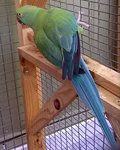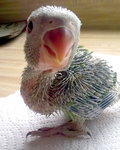

A green Indian ringneck parrot has been roaming the skies over Centralia after she escaped from her owner a week after he brought her home.
Centralia resident Dave Haubrick lost his female breeding parrot when he tried to move her from a transportation cage to a larger outdoor enclosure. He opened the door, thinking the wings of the $450 bird were clipped, and she flew away.
He ran a classified advertisement in The Chronicle for a number of issues in the hopes of tracking down his lost parrot. He received a few calls about his parrot seen off of Graf Road around the houses at the edge of the forest.
“I really didn’t think I would get any calls,” Haubrick said. “I was tickled that people as a community cared and were looking.”
He has received other calls about a parrot sitting on a phone line on Logan Hill, but said it wasn’t his. The owners let that parrot fly around outside because it always comes back home, he said.
The parrot doesn’t have a name because she is a breeding bird, not a pet, Haubrick said. Since his retirement, Haubrick started breeding the birds for something to do.
The escaped parrot was one of his newer females that he had to drive to Salem, Oregon, to get. He had the bird for less than a week before she flew away.
If the general location of the bird can be found, Haubrick said he would place a cage full of food with an open door to attract the bird. The chances are she would roost in it for the night because parrots are conditioned to stay in cages. Then, when the bird is roosting, Haubrick would close the cage door and bring his parrot home.
Haubrick said he would not offer a reward for the return of the parrot because he has already spent a lot of money on the bird and he wants someone to do it an act of kindness rather than for financial gain. He added it is alright if the parrot isn’t found because he intended to use it for breeding purposes.
“It is not like it is life or death,” he said. “I do believe she will be OK until winter.”
The bird is about 17 inches long from head to tail and is bright green. Haubrick said it stands out compared to the other birds in the area.
Although the birds Haubrick keeps are not pets, he sells the young ones as feathered companions.
The parrots go into heat and lay eggs in November or December. When the birds are about 12 days old, Haubrick takes them out of the nest and begins to feed them by hand to get them used to being fed and held. During this time he has to feed them every two hours around the clock, then as the baby birds age he has to feed them less often and will eventually get the feedings down to three times a day. This is when he can get a full night's rest.
Haubrick added every breeder does it differently and this is the way he decided to do it. Haubrick started breeding parrots four years ago but has bred different kinds of birds his entire life, ranging from homing pigeons to chickens.
At about 4 weeks old, the parrots are still fully dependent on someone for feeding and care but are old enough to be given homes, Haubrick said. They are fully grown in 12 weeks.
“They are loveable little birds,” he said.